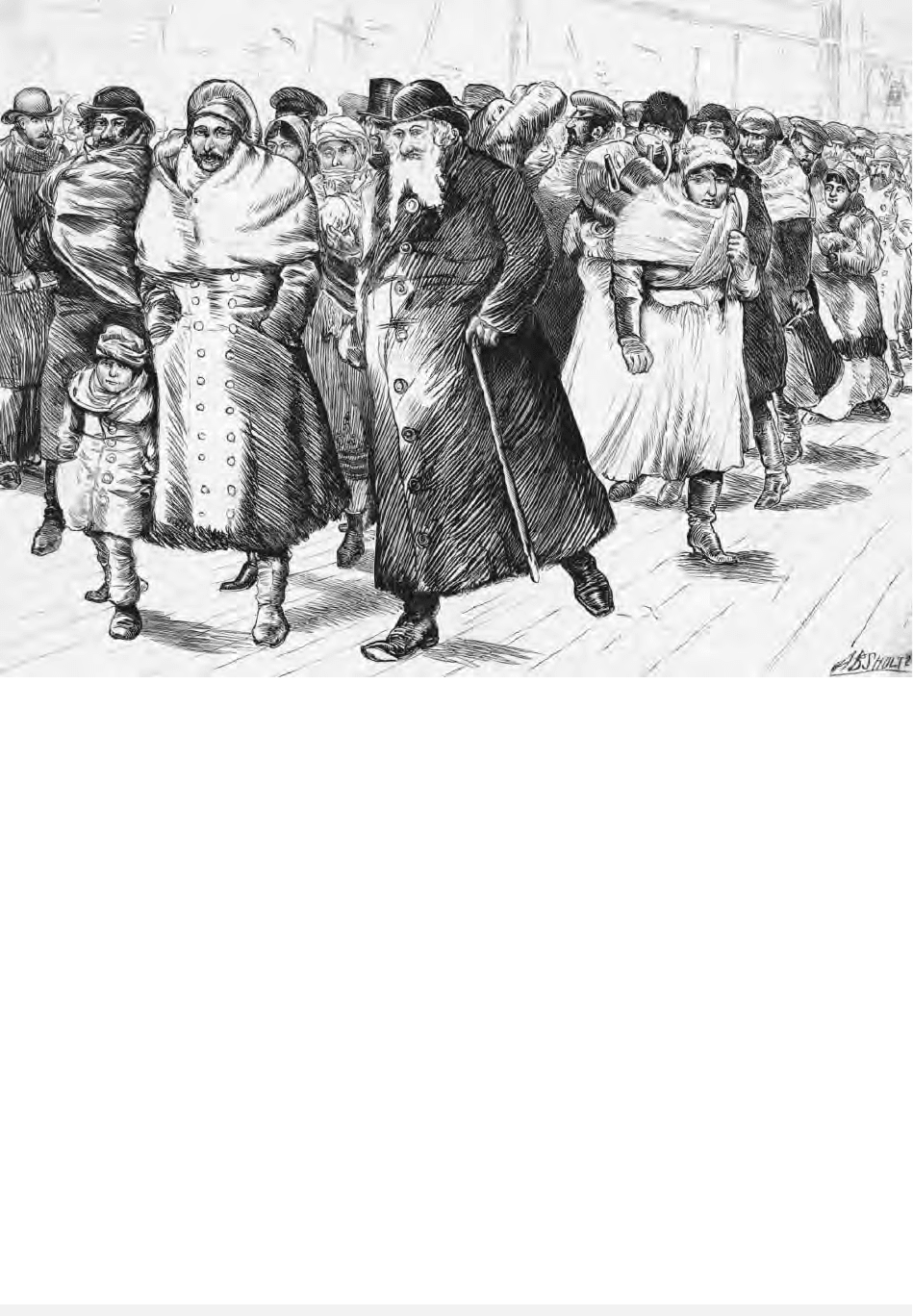Encyclopedia of Russian History
Подождите немного. Документ загружается.


history based on the idea of unity of Russia and Eu-
rope. At the opposite pole, national conservative iso-
lationism found its expression in the works of Pyotr
Alexeyev, Pyotr Bicilli, Nikolai Trubetskoy, Pyotr
Savitsky, Lev Karsavin, and other representatives of
the Eurasian movement. The liberal and conserva-
tive nationalist visions of Russian history are still
present in contemporary thought. The liberal para-
digm coined by Andrei Sakharov was preserved in
the writings of Yegor Gaidar, Boris Fyodorov, Grig-
ory Yavlinsky, and others. Alexander Solzhenitsyn’s
vision of Russian history based on Berdyayev’s
legacy is moderately conservative, while Alexander
Dugin and other neo–Eurasians form the extreme
right wing, advocating an isolationist nationalist ap-
proach to Russia’s past and present.
See also: BERDYAYEV, NIKOLAI ALEXANDROVICH; CHAA-
DAYEV, PETER YAKOVLEVICH; DECEMBRIST MOVE-
MENT AND REBELLION; ENLIGHTENMENT, IMPACT
OF; HEGEL, GEORG WILHELM FRIEDRICH; KARAMZIN,
NIKOLAI MIKHAILOVICH; LOVERS OF WISDOM, THE;
SLAVOPHILES; TOLSTOY, LEO NIKOLAYEVICH; WEST-
ERNIZERS
BIBLIOGRAPHY
Berlin, Isaiah. (1978). Russian Thinkers. London: Hoga-
rth.
Florovsky, Georges. (1979–1987). Ways of Russian The-
ology. 2 vols., tr. Robert L. Nichols. Belmont, MA:
Nordland.
Glatzer-Rosenthal, Bernice, ed. (1986). Nietzsche in Rus-
sia. Princeton, NJ: Princeton University Press.
Kline, George. (1968). Religious and Anti-Religious Thought
in Russia. Chicago: University of Chicago Press.
Lossky, Nicholas. (1951). History of Russian Philosophy.
New York: International Universities Press.
Pipes, Richard, ed. (1961). The Russian Intelligentsia. New
York: Columbia University Press.
Raeff, Marc. (1966). The Origins of the Russian Intelli-
gentsia: The Eighteenth-Century Nobility. New York:
Harcourt, Brace & World.
Riasanovsky, Nicholas. (1952). Russia and the West in the
Teaching of the Slavophiles: A Study of Romantic Ide-
ology. Cambridge, MA: Harvard University Press.
Walicki, Andrzej. (1979). A History of Russian Thought
from the Enlightenment to Marxism, tr. Helen An-
drews-Rusiecka. Stanford, CA: Stanford University
Press.
Zenkovsky, Vasilii. (1953). A History of Russian Philoso-
phy, 2 vols., tr. George L. Kline. New York: Colum-
bia University Press.
B
ORIS
G
UBMAN
IGOR
(d. 945), second grand prince of Kiev, who, like his
predecessor Oleg, negotiated treaties with Constan-
tinople.
Igor, the alleged son of Ryurik, succeeded Oleg
around 912. Soon after, the Primary Chronicle re-
ports, the Derevlyane attempted to regain their in-
dependence from the prince of Kiev. Igor crushed the
revolt and imposed an even heavier tribute on the
tribe. In 915, when the Pechenegs first arrived in Rus,
Igor concluded peace with them, but in 920 he was
forced to wage war. After that, nothing is known
of his activities until 941 when, for unexplained rea-
sons, he attacked Byzantium with 10,000 boats and
40,000 men. His troops ravaged the Greek lands for
several months. However, when the Byzantine army
returned from Armenia and from fighting the Sara-
cens, it destroyed Igor’s boats with Greek fire. In 944
Igor sought revenge by allegedly launching a second
attack. When the Greeks sued for peace, he conceded,
sending envoys to Emperor Romanus Lecapenus to
confirm the agreements that Oleg had concluded in
907 and 911. The treaty reveals that Igor had Chris-
tians in his entourage. They swore their oaths on
the Holy Cross in the Church of St. Elias in Kiev,
while the pagans swore their oaths on their weapons
in front of the idol of Perun. In 945 the Derevlyane
once again revolted against Igor’s heavy-handed
measures; when he came to Iskorosten to collect trib-
ute from them, they killed him. His wife, the es-
teemed Princess Olga from Pskov, then became
regent for their minor son Svyatoslav.
See also: GRAND PRINCE; KIEVAN RUS; PECHENEGS; PRI-
MARY CHRONICLE; RURIKID DYNASTY
BIBLIOGRAPHY
Vernadsky, George. (1948). Kievan Russia. New Haven,
CT: Yale University Press.
M
ARTIN
D
IMNIK
ILMINSKY, NIKOLAI IVANOVICH
(1822–1891), professor of Turkic Languages at
Kazan University and lay Russian Orthodox mis-
sionary, known as “Enlightener of Natives.”
Nikolai Ilminsky gave up a brilliant academic
career to devote himself to missionary work among
ILMINSKY, NIKOLAI IVANOVICH
653
ENCYCLOPEDIA OF RUSSIAN HISTORY

the non-Russians. He was convinced that only
through the mother tongue and native teachers and
clergy could the nominally baptized and animists
become true Russian Orthodox believers and thus
resist conversion to Islam. This conviction was at
the heart of what became known as the “Ilminsky
System.”
In 1863, while still holding the chair of Turkic
languages at both Kazan University and Kazan
Theological Academy, Ilminsky established the
Kazan Central Baptized-Tatar School, which served
as his showcase and model for non-Russian schools
and whose thousands of graduates spawned nu-
merous village schools. In 1867 Ilminsky founded
the Gurri Brotherhood, which supported the grow-
ing network of native schools, and set up the Kazan
Translating Commission. By 1891 the Commission
had produced 177 titles in over a dozen languages;
by 1904 the Commission had produced titles in
twenty-three languages. For most of the lan-
guages, this required the creation of alphabets,
grammars, primers, and dictionaries. Starting with
the baptized Tatars of the Kazan region, Ilminsky’s
activities extended to the multinational Volga-Ural
area, to Siberia, and to Central Asia. But disciples
carried his system further: Ivan Kasatkin, for ex-
ample, founded the Orthodox Church of Japan.
Ilminsky’s system encountered strong opposi-
tion from Russian nationalists who saw in the
Russian language the “cement of the Empire” and
feared that his approach encouraged national self-
esteem among the minorities. Yet by demonstrat-
ing the fervent piety of his students and above all
stressing that the alternative was defection to Is-
lam, he was able to obtain the backing of power-
ful figures in the government and the Church,
including Konstantin Pobedonostev. Ilminsky even
became a quasi-official advisor on nationality af-
fairs and as such promoted strict censorship, un-
favorable appointments, and restrictive laws for
Muslims and Buddhists.
The impact of Ilminsky’s system on preliterate
nationalities was revolutionary, as these peoples,
equipped with a written language and the begin-
nings of a national intelligentsia, experienced a na-
tional awakening. Such national leaders as the
Chuvash Ivan Yakovlev and the Kazakh Ibrai Al-
tynsarin were Ilminsky’s disciples and protégés,
while Lenin’s father worked closely with Ilminsky
in promoting non-Russian education in Simbirsk
Province. This may explain why Lenin’s national-
ity policy, summarized as “national in form, so-
cialist in content” was remarkably similar to
Ilminsky’s system, which was defended by his sup-
porters as “national in form, Orthodox in content.”
See also: EDUCATION; NATIONALITIES POLICIES, TSARIST;
RUSSIAN ORTHODOX CHURCH; TATARSTAN AND
TATARS
BIBLIOGRAPHY
Dowler, Wayne. (2001). Classroom and Empire: The Poli-
tics of Schooling Russia’s Eastern Nationalities,
1860–1917. Montreal: McGill-Queen’s University
Press.
Kreindler, Isabelle. (1977). “A Neglected Source of Lenin’s
Nationality Policy.” Slavic Review 36:86–100.
I
SABELLE
K
REINDLER
IMMIGRATION AND EMIGRATION
To paraphrase the nineteenth-century historian of
Russia, Vasily Klyuchevsky, the history of Russia
is the history of migration. The Kievan polity itself
was founded by Varangian traders in the ninth cen-
tury, then populated by the steady migration and
population growth of Slavic agriculturalists. By the
sixteenth century the attempt to control popula-
tion movement became one of the most important
tasks of the Muscovite state. Serfdom (i.e., elimi-
nation of the right of peasants to move from one
lord to another) was entrenched in the late sixteenth
and early seventeenth centuries by the tsars of
Muscovy in order to ensure that their servitors could
feed their horses and buy sufficient weaponry. Serf-
dom’s logic led to an elaborate system of controls
over movement within the country and of course
precluded any possibility of legal emigration for the
vast majority of the population. The Muscovite
polity also developed mechanisms to prevent the
departure of its servitors and elites. Peasant flight—
often to join the Cossacks in border regions—was
not a negligible phenomenon, and there were sev-
eral exceptional mass emigrations. Most notable
was the departure of an estimated 400,000
Crimean Tatars, Nogai, and Kalmyks in the late
eighteenth century after the annexation of their
lands by the Russian Empire, and another mass em-
igration in the 1850s and 1860s of Adygs,
Cherkess, Nogai, and others after the completion of
the conquest of the Caucasus. But regular yearly
emigration did not occur on a significant scale un-
til the 1860s.
IMMIGRATION AND EMIGRATION
654
ENCYCLOPEDIA OF RUSSIAN HISTORY

Thus it would be logical to link the first ap-
pearance of steady yearly emigration with the
emancipation of the serfs in 1861. But this rela-
tionship is not so clear. Of the four million emi-
grants from the Russian Empire from 1861 to
1914, less than 3 percent were Russians. The vast
majority were Jews and Germans, neither of which
had been under serfdom. It was probably not serf-
dom so much as the commune, with its systems
of collective responsibility and partible inheritance,
that kept emigration figures so low for Russians.
A massive emigration of Germans began in the
1870s in reaction to the abolition of their exemp-
tion from military conscription and continued due
to the increasingly serious shortage of fertile lands
in the Russian Empire as a result of population
growth. Nearly 1.5 million Jews emigrated from
1861 to 1914, both in reaction to ongoing gov-
ernment repression and pogroms and in order to
take advantage of civic equality and economic
opportunities available in the United States and
elsewhere. The sudden and massive increase in em-
igration also had a great deal to do with the trans-
portation revolution, which brought cheap railroad
and steamship tickets, making intercontinental
travel possible for those of modest means.
While the tsar selectively recruited and encour-
aged immigrants from Europe to serve as soldiers,
technicians, architects, and engineers on a fairly ex-
tensive scale by the sixteenth and seventeenth cen-
turies, the second half of the eighteenth century
was the heyday of immigration to the Russian Em-
pire. Inspired by physiocratic notions that the pop-
ulation is the fundamental source of wealth, and
eager to populate the vast, fertile, untilled south-
ern steppe that they had conquered, empresses
Elizabeth and Catherine created very favorable
conditions for immigrants in the mid-eighteenth
century. These included free grants of land, perma-
nent exemption from military service, temporary
IMMIGRATION AND EMIGRATION
655
ENCYCLOPEDIA OF RUSSIAN HISTORY
Russian Jewish exiles arrive in New York City. © B
ETTMANN
/CORBIS

exemption from taxes, and even a degree of reli-
gious freedom. The result was a rapid and massive
immigration that slowed only in the mid- to late
nineteenth century as the amount of free land de-
clined. By the late nineteenth century, as a result
of rapid population growth after the emancipation
of the serfs, a shortage of land led the regime to
reverse its encouragement of immigration and im-
pose some serious restrictions upon it.
Immigration did not take place on a major scale
at any period under Soviet rule. While technical ex-
perts were recruited from the West in the 1930s,
and workers came to the Soviet Union in relatively
small numbers in the 1920s, and then again in the
1950s, on the whole, immigration was remarkably
small in scale throughout the entire Soviet period.
Likewise, emigration was illegal throughout
the Soviet era, and it occurred on a significant scale
only on an exceptional basis. During the Civil War,
before the Bolsheviks established firm control over
the entire territory of the state, a major emigration
of political opponents of the regime and others oc-
curred. By some estimates roughly 2 million peo-
ple left from 1918 to 1922. The next major exodus
occurred as a result of World War II, which left
millions of Soviet civilians and soldiers as displaced
peoples in areas occupied by Russia’s allies. Millions
were returned after the war—often against their
will—as a result of allied agreements. But at least
a half million were able to emigrate permanently.
The next major wave of emigration came in the
1970s when Soviet Jews were allowed to leave in
relatively substantial numbers. While only about
10,000 Soviet Jews emigrated from the Soviet
Union from 1954 to 1970, an average of 22,800
emigrated per year from 1971 to 1980. Soviet Jew-
ish emigration was sharply curtailed in the 1980s,
but when restrictions were first eased in 1988 and
then effectively removed in 1990, a mass emigra-
tion of roughly a million Jews occurred. Soviet
German emigration followed a similar pattern,
though fewer Germans were allowed to emigrate
prior to 1988. A mass emigration of nearly 1.5 mil-
lion Soviet Germans, encouraged by the German
policy of automatically granting citizenship (and
generous access to welfare and public services), oc-
curred from 1988 to 1996. In the 1990s economic
difficulties led to large emigrations of Russians and
other groups as well. This wave of emigration be-
gan to slow by the end of the 1990s, but it re-
mained important and a matter of concern at the
beginning of the twenty-first century, especially
considering the continuing high rates of emigra-
tion among well-educated and highly trained young
people.
See also: DEMOGRAPHY; GERMAN SETTLERS; JEWS; NA-
TIONALITIES POLICY, SOVIET; NATIONALITIES POLICY,
TSARIST
BIBLIOGRAPHY
Bartlett, Roger P. (1979). Human Capital: The Settlement
of Foreigners in Russia, 1762–1804. Cambridge, UK:
Cambridge University Press.
E
RIC
L
OHR
IMPERIAL RUSSIAN
GEOGRAPHICAL SOCIETY
Legend holds that the idea for the Russian Geo-
graphical Society (RGS) arose at a dinner party
thrown by A. F. Middendorf in St. Petersburg in
1845. Middendorf had just returned from his fa-
mous expedition to Eastern Siberia. He, along with
Fyodr Litke, Karl Ber, and Ferdinand Wrangel, con-
ceived the society, which ultimately attracted
seventeen charter members, including the most
prominent Russian explorers, scientists, and public
officials of their day. The goal was systematically
to expand and quantify the understanding of their
country, which was still relatively unknown. Geo-
graphical societies elsewhere in the world (England,
France, Prussia, and so on) were mainly concerned
with general geography, whereas homeland geog-
raphy (domashnyaya geografiya) was for them sec-
ondary. The early founders of the RGS thus were
leading proponents of the nationalist reform-
minded movement that perfused Russia in the mid-
1800s. The emphasis would be upon Russia’s special
place in the world: its diversity of climates, lan-
guages, customs, peoples, and so forth.
Although, early on, members wished to call it
the “Russian Geographical-Statistical Society,” on
August 18, 1845, Tsar Nicholas I declared that it
would be named the “Russian Geographical Soci-
ety”; this remained the official name for the next
five years. In October 1845, the majority of the
charter members held their first meeting and se-
lected 51 active members from throughout Russia.
After 1850 the society was renamed the Imperial
Russian Geographical Society (Imperatorskoye russkoye
geograficheskoye obshchestvo [IRGS]), an appellation
that would persist until 1917.
IMPERIAL RUSSIAN GEOGRAPHICAL SOCIETY
656
ENCYCLOPEDIA OF RUSSIAN HISTORY

Almost immediately after its founding, the RGS
became a polestar for opponents of Nicholas I. It be-
came one of the ideological centers of the struggle
against serfdom and had direct links to Russian
utopian socialists, such as the Petrashevsky Circle.
Its titular leader was the tsar’s second son, Grand
Prince Constantine, who represented the most
“progressive” (i. e., nationalistic) ideas of that time.
Within the society, conflict arose between the
largely non-Russian founders (the Baltic Germans)
and the ethnically pure Russian contingent.
Throughout the rest of the nineteenth century, the
IRGS stressed Russia’s messianic mission in Asia,
and most of the society’s sponsored expeditions, in-
cluding the famous Amur expedition of 1855–1863,
were indeed carried out in Asia. By 1917 the IRGS
had compiled a legacy of 1,500 volumes of schol-
arly literature.
See also: GEOGRAPHY; RUSSIAN GEOGRAPHICAL SOCIETY
BIBLIOGRAPHY
Bassin, Mark. (1983). “The Russian Geographical Soci-
ety, the ‘Amur Epoch,’ and the Great Siberian Expe-
dition, 1855–1863.” Annals of the Association of
American Geographers 73:240–256.
Harris, Chauncey D., ed. (1962). Soviet Geography: Ac-
complishments and Tasks, tr. Lawrence Ecker. New
York: American Geographical Society.
V
ICTOR
L. M
OTE
IMPERIAL RUSSIAN
TECHNOLOGICAL SOCIETY
In the era before the revolution, the Imperial Russ-
ian Technical Society (IRTS) was the most impor-
tant and oldest technical organization in Russia.
Founded in 1866 in St. Petersburg on the model of
similar societies across Europe, it brought together
scientists, engineers, and other people interested in
promoting technological development. Subsidized
by the Ministry of Public Education, the Ministry
of Finances, and other government agencies, and
by industry, it focused on inventions and the ap-
plication of technology in order to further the
development of Russia’s manufacturing and pro-
duction industries and foster the country’s overall
industrial and economic growth. Headed by scien-
tists such as chemist Dmitry I. Mendeleyev and mil-
itary engineer and chemist Count Kochubei, IRTS
encouraged greater cooperation between govern-
ment and the world of science, technology, and in-
dustry.
The members of IRTS were concerned about the
output of Russia’s weak private sector and felt that
the technology policy of the tsarist state was in-
adequate, especially in the military sphere. This
view was confirmed by the Russo-Japanese War
(1904–1905), and in fact it was not until then that
the government began to encourage IRTS in its sup-
port of aviation. World War I provided IRTS with
another opportunity to demand greater state sup-
port for scientific and technological research.
From the outset IRTS was strongly committed
to the dissemination of technical education, favor-
ing the polytechnic model at the university level
rather than specialized institutes, because students
in schools of the former type would be more cre-
ative and flexible in their future jobs. In addition
to technical schools and special classes, it conducted
night schools for adults. It also tried to popularize
technological development by organizing a techni-
cal library, a technical museum, and an itinerant
museum, and by publishing science books for tech-
nical schools. As early as 1867 IRTS started pub-
lishing a magazine, Notes from the Imperial Russian
Technical Society (Zapiski IRTO), and organizing
meetings on technical subjects and on technical and
professional training. Finally, it distributed awards
and medals in support and reward of inventions
and research and applications in the field of tech-
nology.
IRTS was a national organization and had a
network of correspondents throughout Russia.
Starting in the 1860s it had offices in many
provinces. By 1896 there were twenty-three of
these, some of which published their own maga-
zines. In 1914 IRTS had two thousand members,
four times as many as when it began. The Russ-
ian Technical Society continued its activities until
1929, when it was eliminated on the grounds that
it was an organization of bourgeois specialists.
See also: ACADEMY OF SCIENCES; MENDELEYEV, DMITRY
IVANOVICH; MOSCOW AGRICULTURAL SOCIETY; SCI-
ENCE AND TECHNOLOGY POLICY
BIBLIOGRAPHY
Bailes, Kendall E. (1978). Technology and Society under
Lenin and Stalin. Origins of the Soviet Technical Intel-
ligentsia, 1917-1941. Princeton: Princeton University
Press.
IMPERIAL RUSSIAN TECHNOLOGICAL SOCIETY
657
ENCYCLOPEDIA OF RUSSIAN HISTORY

Balzer, Harley D. (1980). “Educating Engineers: Eco-
nomic Politics and Technical Training in Tsarist Rus-
sia.” Ph.D. diss., University of Pennsylvania.
Balzer, Harley D. (1983). “The Imperial Russian Techni-
cal Society.” In The Modern Encyclopedia of Russian
and Soviet History, edited by Joseph L. Wieczynski,
Vol. 32, 176-180. Gulf Breeze, FL: Academic Inter-
national Press.
Balzer, Harley D. (1996). “The Engineering Profession in
Tsarist Russia.” In Russia’s Missing Middle Class: The
Professions in Russian History, edited by Harley D.
Balzer, 55-88. Armonk, NY: M. E. Sharpe.
Blackwell, William. (1968). The Beginning of Russian In-
dustrialization. Princeton: Princeton University Press.
M
ARTINE
M
ESPOULET
INDEX NUMBER RELATIVITY
The period of the first Five-Year Plans and the rapid
collectivization of Soviet agriculture, 1929–1937,
witnessed rapid economic growth accompanied
by radical changes in the structure of the Soviet
economy—first, from a predominantly agricultural
towards an industrial one, and second, within in-
dustry, from a predominantly smaller-scale econ-
omy of light and consumer industries, to heavy
industry, machinery, construction, and transporta-
tion. The vast expansion and mass production of
heavy manufacturing goods reduced their cost of
production, relative to those of light industry and
of agricultural products. This phenomenon of si-
multaneous changes in the structure of production
and relative prices during periods of rapid economic
growth in the Soviet context was discovered and
analyzed by Alexander Gerschenkron when he es-
timated the rate of economic growth of Soviet man-
ufacturing during this period. Growth of the
national product (GNP) of a country is estimated
by a quantity index, aggregating the growth of pro-
duction of individual sectors by assigning to each
sector a “weight” corresponding to the average price
of the products of this sector at a certain point of
time during the period under investigation. It has
been demonstrated that when the relative prices of
the expanding sector are declining, as in the Soviet
Union during the 1930s, the index produces a
much higher rate of growth when prices of the ini-
tial period are used as weights than the index
that uses prices at the end of the period. The first
is called a Laspeyres index and the second a Paasche
index, both named after their developers. Under the
Laspeyres index, relatively higher prices, and hence
larger weights, are assigned to faster growing sec-
tors, thus producing a higher aggregate rate of
growth, and vice versa. Hence the term “index num-
ber relativity.”
One commonly quoted calculation of the two
indexes for the period 1928 to 1937 is Abram Berg-
son’s: According to his estimates Soviet GNP grew
over that period by 2.65 times according to the
Laspeyres variant but only by 1.54 times accord-
ing to the Paasche index (1961, Table 18, p. 93).
The two measures apparently present two very dif-
ferent views on the achievements of the Soviet
economy during this crucial period, as well as on
the estimates of economic growth over the longer
run. However, since both are “true,” they must be
telling the same story. One commonly used “solu-
tion” to dealing with this relativity was to use the
(geometric) average of the two estimates. An alter-
native was to replace both measures by a Divisia
index (also named after its developer) that calcu-
lates growth for every year separately using prices
of that year as weights, and then add up all growth
rates for the entire period. The outcome is usually
not far away from the average of the Laspeyres
and Paasche indexes. Subsequent estimates of So-
viet GDP growth over this period offered a variety
of amendments to the original ones; some among
them narrowed the gap between the two indices.
During the rest of the Soviet period, the second half
of the twentieth century, index number relativity
did not play an important role, mostly because the
major structural changes were accomplished al-
ready before World War II.
See also: COLLECTIVIZATION OF AGRICULTURE; ECONOMIC
GROWTH, SOVIET; FIVE-YEAR PLANS
BIBLIOGRAPHY
Bergson, Abram. (1961). The Real National Income of So-
viet Russia since 1937. Cambridge, MA: Harvard Uni-
versity Press.
Gerschenkron, Alexander. (1947). “The Soviet Indexes of
Industrial Production.” Review of Economics and Sta-
tistics 29:217–226.
G
UR
O
FER
INDICATIVE PLANNING
As distinct from directive planning, as practiced in
the Soviet Union from 1928 onward, indicative
planning is a set of consistent numerical projections
INDEX NUMBER RELATIVITY
658
ENCYCLOPEDIA OF RUSSIAN HISTORY

of the economic future without specific incentives
for their fulfillment. Rather, the indicative plan is
conceived as coordinated information that guides
the choices of separate entities in the market econ-
omy.
The first indicative plans were those made up
by Gosplan in the USSR during the mid-1920s.
These were soon integrated into mandatory in-
structions issued by the Supreme Council of the
National Economy (VSNKh), later by Gosplan it-
self. The output plans were supplemented by ma-
terial balances, inspired by German experience
during World War I and generalized as input-
output analysis in the work of Wassily Leontief
and others.
During and immediately after World War II
economists in Continental Europe developed the
idea of indicative planning as a guide to recovery
and to ongoing short-term economic policy mak-
ing. Notable were the Central Planning Bureau in
the Netherlands, led by Jan Tinbergen, the French
Commissariat Général du Plan, inspired by Jean
Monnet, and the Japanese Economic Planning
Agency. In all of these, government agencies play
a role in collecting and developing the information
necessary to build a multi-sectoral econometric
model. Such a model allows alternative policy in-
struments to be tested for their effects on such tar-
gets as inflation, the growth rate, and the balance
of payments. While indicative planning assumes a
primarily private market economy with competi-
tion from outside the country, the concertation (un-
official collusion) of private investment plans—as
practiced in France and Japan—is supposed to avoid
duplication of effort, increase investment volumes,
and perhaps reduce cyclical instability. Japanese
and French bureaucrats have also guided invest-
ment funds from state-controlled sources into fa-
vored projects. In practice, however, it is doubtful
that indicative planning has had much positive in-
fluence on the economic performance of these
economies, particularly as they opened themselves
up to international trade and capital flows.
Communist Yugoslavia adopted a kind of in-
dicative planning in the 1950s. The main purpose
was to guide the distribution of capital to self-
managed enterprises throughout the republics of
that country. After the fall of Communism, in-
dicative planning was also adopted in Poland. The
theoretical basis for indicative planning in a social-
ist context was developed by Janos Kornai and his
coauthors, but practice never conformed to such
rational schemes.
Indicative planning should be distinguished from
so-called “indirect planning,” embodied in the New
Economic Mechanism in Hungary in 1968 and con-
templated by Soviet reformers of the late 1980s.
Instead of establishing a mixed or regulated mar-
ket economy, as in Western Europe, the Commu-
nist authorities continued to dominate the economy
through investment and supply planning, as well
as subsidies. In both Hungary and Gorbachev’s
Russia, a weak budget constraint on wages and
other costs led to inflationary pressure and short-
ages, along with rising external debts. These prob-
lems contributed to the collapse of indirect planning.
See also: GOSPLAN; INPUT-OUTPUT ANALYSIS
BIBLIOGRAPHY
Ellman, Michael. (1990). “Socialist Planning.” In Prob-
lems of the Planned Economy, edited by John Eatwell,
Murray Milgate, and Peter Newman. New York:
Norton.
Kornai, Janos. (1980). Economics of Shortage. Amsterdam:
North-Holland.
M
ARTIN
C. S
PECHLER
INDUSTRIALIZATION
The concept of industrialization implies the move-
ment of an economy from a primarily agricultural
basis to a mixed or industrial/service basis with an
accompanying increase in output and output per
capita. Although the early stages of industrializa-
tion require systemic and policy measures to steer
resources into the productive process, eventually
the growth of output must be generated through
the growth of productivity. During the process of
successful industrialization, measurement of the
importance of the agricultural and industrial sec-
tors, characterized for example by output shares in
GDP, will indicate a relative shift away from agri-
cultural production towards industrial production
along with the sustained growth of total output.
The analysis of these changes differs if cast within
the framework of neoclassical economics (and its
variations) as opposed to the Marxist-Leninist
framework. Much of our analysis of the Russian
economy during the Tsarist era and the subsequent
events of the Soviet era have focused on the process
of industrialization under varying institutional
arrangements, policy imperatives, and especially
changing ideological strictures.
INDUSTRIALIZATION
659
ENCYCLOPEDIA OF RUSSIAN HISTORY

To the extent that Lenin and the Bolshevik
Party wished to pursue the development of a so-
cialist and ultimately a communist economic sys-
tem after the Bolshevik revolution of 1917, the
relevant issue for the Bolshevik leadership was the
degree to which capitalism had emerged in pre-
revolutionary Russia. Fundamental to industrial-
ization in the Marxist-Leninist framework is the
development of capitalism as the engine of progress,
capable of building the economic base from which
socialism is to emerge. Only upon this base can in-
dustrial socialism, and then communism, be built.
From the perspective of classical and neoclassical
economic theory, by contrast, the prerequisites for
industrialization are the emergence of a modern
agriculture capable of supporting capital accumu-
lation, the growth of industry, the transformation
of population dynamics, and the structural trans-
formation of the Russian economy placing it on a
path of sustained economic growth.
While there is considerable controversy sur-
rounding the events of the prerevolutionary era
when cast in these differing models, the level of eco-
nomic development at the time of the Bolshevik
revolution was at best modest, and industrializa-
tion was at best in early stages. From the stand-
point of neoclassical economic theory, structural
changes taking place were consistent with a path
of industrialization. However, from a Marxist-
Leninist perspective, capitalism had not emerged.
The relevance of disagreements over these issues
can be observed if we examine the abortive period,
just after the Revolution of 1917, of War Com-
munism. While indeed an attempt was made dur-
ing this period to move towards the development
of a socialist economy, these efforts contributed lit-
tle, if anything, to the long-term process of indus-
trialization.
Although during the New Economic Policy
(NEP) a number of approaches to industrialization
were discussed at length, the outcome of these dis-
cussions confirmed that ideology would prevail.
The Marxist-Leninist framework would be used,
even in a distorted manner, as a frame of reference
for industrialization, albeit with many institutional
arrangements and policies not originally part of
the ideology. While the institutional arrangements
based upon nationalization and national economic
planning facilitated the development and imple-
mentation of socialist arrangements and policies,
priority was placed nonetheless on the rapid accu-
mulation of capital, a part of the process of indus-
trialization that should have occurred during the
development of capitalism, according to Marx.
Thus, while an understanding of the elements of
Marxism-Leninism is useful for the analysis of this
era, most Western observers have used the stan-
dard tools of neoclassical economic theory to as-
sess the outcome.
During the command era (after 1929), indus-
trialization was initially rapid, pursued through a
combination of command (nonmarket) institutions
and policies within a socialist framework. The
replacement of private property with state owner-
ship facilitated the development of state institu-
tions, which, in combination with command
planning and centralized policy-making, ensured a
high rate of accumulation and rapid expansion of
the capital stock. In effect, the basic components of
industrialization traditionally emerging though
market forces were, in the Soviet case, implemented
at a very rapid pace in a command setting, effec-
tively replacing consumer influence with plan pre-
rogatives. The pace and structural dimensions of
industrialization could, with force, therefore be
largely dictated by the state, at least for a limited
period of time. Private property was eliminated, na-
tional economic planning replaced market arrange-
ments, and agriculture was collectivized.
For some, the emergence of Soviet economic
power and its ultimate collapse presents a major
contradiction. While there is little doubt that a ma-
jor industrial base was built in the Soviet Union, it
was built without respect for basic economic prin-
ciples. Specifically, because the command economy
lacked the flexibility of market arrangements and
price messages, resources could be and were allo-
cated largely without regard to long-term produc-
tivity growth. The command system lacked the
flexibility to ensure the widespread implementation
of technological change that would contribute to
essential productivity growth. Finally, and signif-
icantly, the socialization of incentives failed, and
the consumer was largely not a part of the indus-
trial achievements. Even the dramatic changes of
perestroika during the late 1980s were unable to
shift the Soviet economy to a new growth path
that favored rational and consumer-oriented pro-
duction.
Industrialization in the post-1990 transition
era was fundamentally different from that of ear-
lier times. First, the ideological strictures of the past
were largely abandoned, though vestiges may have
remained. Second, to the extent that the command
era led to the development of an industrial base in-
INDUSTRIALIZATION
660
ENCYCLOPEDIA OF RUSSIAN HISTORY

appropriate for sustaining long term economic
growth and economic development, the task at
hand became the modification of that industrial
base. Third, the modification of the industrial base
required the development of new institutions and
new policies capable of implementing necessary
changes that would place the contemporary Russ-
ian economy on a long-term sustainable growth
path. It is this challenge that separated the early
stages of industrialization from the process of in-
dustrialization during transition, since the latter
implies changes to an existing structure rather than
the initial development of that structure.
The process of industrialization is necessarily
modified and constrained by a variety of environ-
mental factors. In the case of Russia, those envi-
ronmental factors should be largely positive insofar
as Russia is a country of significant natural wealth
and human capital.
See also: ECONOMIC GROWTH, SOVIET; INDUSTRIALIZA-
TION, RAPID; INDUSTRIALIZATION, SOVIET
BIBLIOGRAPHY
Gregory, Paul R., and Stuart, Robert C. (2001). Russian
and Soviet Economic Performance and Structure, 7th ed.
New York: Addison Wesley Longman.
Millar, James R. (1981). The ABCs of Soviet Socialism. Ur-
bana: University of Illinois Press, 1981.
Nove, Alec. (1981). The Soviet Economic System. London:
Unwin Hyman.
R
OBERT
C. S
TUART
INDUSTRIALIZATION, RAPID
Soviet growth strategy was focused on fast growth
through intensive industrialization. It involved the
self-development of an industrial base, concen-
trated in capital goods or “means of production,”
also dubbed “Sector A” according to Marxian jar-
gon. It became the official strategy of the Soviet
leadership as a resolution of the Soviet Industrial-
ization debate that occupied communist thinkers
and politicians during the mid-1920s. The indus-
trialization debate considered two growth strate-
gies. One, supported by moderates and led by
Nikolai Bukharin, advocated an extension of the
New Economic Policy (NEP), centered on industri-
alization but based on the initial development of
agriculture, mostly by individual and independent
farmers. A prospering agricultural sector would
create demand on the part of both consumers and
producers for industrial goods, as well as surplus
resources in terms of savings, to finance this in-
dustrialization. While all sectors of manufacturing
would be developed, surplus agricultural products
would be used as exports in order to import ma-
chinery and technology from the West. Advocates
of the alternative strategy, including leaders of the
left such as Leon Trotsky, preferred a more rapid
state-led industrialization drive, concentrated in
large state-owned heavy industrial enterprises
financed by forced savings, extracted from collec-
tivized (thus supposedly more productive) agricul-
ture and from the population. While machinery
and technology would be imported, the main
thrust would be to build an indigenous heavy in-
dustrial base and early self-sufficiency in all in-
dustrial goods, and more autarky. The high level
of forced savings would minimize consumption
and hence provide for higher rate of investment,
faster growth, and a relatively smaller “Sector B”
of consumer goods and light industry; in contrast
with a normal path of early development of light
and consumer goods industries, followed by grad-
ual move toward the production of machinery
and capital goods. The more radical variant was
also more consistent with Marxian doctrine and
teaching.
Josef Stalin used the industrialization debate as
a leverage to gain control, first by siding with the
moderates to oust Trotsky and his followers, and
then by ousting the moderates and adopting an
even more extreme variant of forced industrializa-
tion. Other motivations for his choice of the heavy
industrialization route were the Soviet Union’s rich
endowment of natural resources (coal, iron ores,
oil, and gas), and the need (facing external threats),
or desire, to develop a strong military capability.
This strategy guided the industrialization drive
throughout, with only some easing off toward the
end of the Soviet period. The 1930s were charac-
terized by the construction of a large number of
giant industrial, power, and transportation projects
that involved moving millions of people to new and
old cities and regions. This was also the period
when collectivized agriculture was expected to pro-
vide surplus products and resources to feed the
growing industrial labor force and to export in ex-
change for modern technology. Students of the pe-
riod differ on the extent to which this really
happened, and some claim that most of the ex-
tracted surplus through food procurements had to
INDUSTRIALIZATION, RAPID
661
ENCYCLOPEDIA OF RUSSIAN HISTORY

be reinvested in machinery and other inputs needed
to make the new collective and state farms work.
With the increasing threat of war toward the end
of the 1930s, manufacturing became more oriented
toward military production. Much of the indus-
trial effort during the war years was directed to-
ward the production of arms, but it was also
characterized by a gigantic transfer of many hun-
dreds of enterprises from the western parts of the
USSR eastward to Siberia and the Far East in order
to protect them from the advancing German army.
This transfer happened to be consistent with an ex-
plicit goal of the regime to develop the east and
northeast, the main concentration of natural re-
sources, an effort that was facilitated over the years
through the exploitation of millions of forced la-
bor workers.
The rate of industrial growth in the Soviet
Union was higher than that of agriculture and ser-
vices, and the share of industry in total output and
in the labor force increased over time as in any de-
veloping country. Except that in the Soviet Union
these trends were stronger: The gaps in favor of in-
dustry were wider, also due to the deliberate con-
straint on the development of the service sector,
considered nonproductive according to Marxian
doctrine. Thus the share of industrial output in
GNP climbed to more than 40 percent in the 1980s,
significantly above the share in other countries of
similar levels of economic development. The share
of industrial labor was not exceptionally high due
to the concentration of capital and of labor-saving
technology. This over-industrialization, including
noncompetitive industries, even some creating neg-
ative value, was recognized in the 1990s as a drag
on the ability of former Communist states to ad-
just to a normal market structure and an open
economy during the transition. The autarkic pol-
icy of industrialization pursued over most of the
Soviet period contributed to a technological non-
compatibility with the West, which further hurt
the competitiveness of Soviet industry.
The bias of Soviet industrialization toward Sec-
tor A of investment and capital, as well as military
goods, is apparent in the internal structure of in-
dustry. The share of Sector A industry grew fast
to almost half of total industry and stayed at
approximately that level throughout the entire pe-
riod. It was also estimated that during the 1970s
and 1980s military-related production occupied a
substantial share of the output of the machine-
building and metalworking sector as well as more
than half the entire activities of research and de-
velopment. The development of consumer and light
industry (“Sector B,” under Marxian parlance) was
not only limited in volume; it also suffered from a
low priority in the planning process and thus from
low quality and technological level. “Sector A” in-
dustries, including the major military sector, en-
joyed preferential treatment in the allocation of
capital and technology, of high-quality labor re-
sources and materials, and of more orderly and
timely supplies. Hence some of the technological
achievements in the spheres of defense and space.
Hence also the very high costs of these achieve-
ments to the economy at large and to Sector B
consumer industries in particular, which were
characterized by low-quality and lagging tech-
nology, limited assortment, and perennial short-
ages. This policy of priorities also explains the
very limited construction resources allocated to
housing and to urban development, causing hous-
ing shortages, as well as the very low production
of private cars and (to a lesser extent) household
appliances. The biased structure of industry became
also a serious barrier for restructuring under the
transition.
See also: COLLECTIVIZATION OF AGRICULTURE; ECONOMIC
GROWTH, SOVIET; INDUSTRIALIZATION
BIBLIOGRAPHY
Bergson, Abram. (1961). The Real National Income of So-
viet Russia since 1928. Cambridge, MA: Harvard Uni-
versity Press.
De Melo, Martha; Denizer, Cevdet; Gelb, Alan; and Tenev,
Stoyan. (1997). “Circumstance and Choice: the Role
of Initial Conditions and Policies in Transition
Economies.” World Bank, Policy Research Working Pa-
per no. 1866.
Domar, Evsey. (1953). “A Soviet Model of Growth.” In
his Essays in the Theory of Economic Growth. New
York: Oxford University Press.
Easterly, William, and Fischer, Stanley. (1995). “The So-
viet Economic Decline: Historical and Republican
Data.” World Bank Economic Review, 9(3):341–371.
Erlich, Alexander. (1960). The Soviet Industrialization De-
bate, 1924–1928. Cambridge, MA: Harvard Univer-
sity Press.
Millar, James R. (1990) The Soviet Economic Experience.
Urbana, University of Illinois Press.
Ofer, Gur. (1987). “Soviet Economic Growth, 1928–1985.”
Journal of Economic Literature 25(4):1767–1833.
G
UR
O
FER
INDUSTRIALIZATION, RAPID
662
ENCYCLOPEDIA OF RUSSIAN HISTORY
